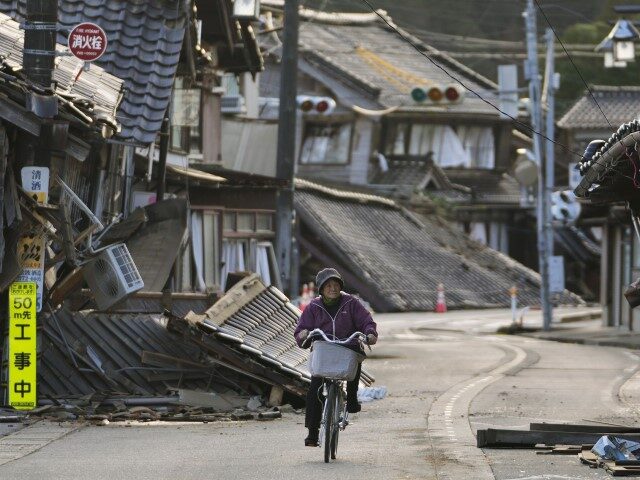The mayor of Suzu, Japan, estimated that “90 percent of houses” in the small peninsula town were either “completely or nearly completely destroyed” in remarks Tuesday following a devastating 7.6 magnitude earthquake near his city.
The earthquake struck on Monday, January 1, on Japan’s Noto Peninsula on the west coast of Japan’s Honshu island. The area has experienced over 90 aftershocks of much smaller intensity since the initial quake and geologists warn that subsequent aftershocks may be stronger, requiring the evacuation of as many people as possible. Authorities lifted their most severe tsunami warnings on Tuesday.
“Very extensive damage has been confirmed, including numerous casualties, building collapses and fires,” Prime Minister Kishida Fumio said on Tuesday. “We have to race against time to search for and rescue victims of the disaster.”
As of Tuesday afternoon local time, Japanese authorities have confirmed the deaths of 48 people as a result of the earthquake and subsequent tsunami and fires. The true death toll is likely to be much higher, as emergency workers and Japan’s Self-Defense Forces (SDF) struggle to access the Noto Peninsula; images taken by locals show major roads into the peninsula heavily cracked, full of holes, or covered in seaweed and mud. Kishida mobilized 10,000 SDF troops to respond to the earthquakes, not just rescuing those still trapped but ensuring that survivors are fed, clothed, and sheltered.
“Take all possible measures to support the victims by securing supplies such as food, blankets and fuel, providing medical treatment and restoring infrastructure such as electricity and water supply,” Kishida ordered.
Reports indicated on Tuesday local doctors could not reach Suzu’s hospital due to the destruction of the roads. Similarly, many of the thousands of first responders dispatched from elsewhere in the country are struggling to find roads sufficiently intact to enter Suzu, Wajima, and other highly damaged areas, as cracks sent pieces of the road feet into the air.
Asahi reported that potential nuclear disaster was averted by chance: “Hokuriku Electric’s Shika plant, the closest to the epicenter, had already halted its two reactors before the quake for regular inspections and saw no impact from the quake.”
In addition to the dead and missing, over 57,000 people have been displaced, seeking shelter at public emergency shelters or in makeshift tents. Japan is currently experiencing freezing winter temperatures, which threaten the lives of survivors who may be under rubble. Much of the affected area, including about 45,000 homes, is believed to have no access to electricity, and multiple water pipe bursts suggest access to clean water is also limited.
“The situation is devastating, as about 90 percent of houses have been completely or nearly completely destroyed,” Suzu Mayor Masuhiro Izumiya told reporters at a press meeting on Tuesday, according to Kyodo. Asahi noted that Suzu endured a “major quake” in May 2023 and much of the town, home to about 5,000 residents and 14,000 people, had sustained structural damage it had not yet repaired, leaving the homes vulnerable.
The newspaper quoted Tzumiya stating that “about 1,000 houses have been completely destroyed” at the same press briefing and lamenting of those that may remain standing, “We can’t even confirm their safety. We are in a very difficult situation.”
Suzu is on the tip of the peninsula and thus one of municipalities believed to be most devastated by the earthquake, the tsunami that followed, and subsequent fires and landslides. Other cities and towns such as Noto and neighboring Wajima have also suffered substantial damage. In Wajima, Japan’s Kyodo News reported, over 200 buildings succumbed to a city-wide fire.
“Plumes of white smoke rose above Wajima where the water in the Sea of Japan turned a reddish-brown shade from the dirt and sand kicked up by the retreating waves,” the Japanese newspaper Asahi Shimbun reported.
Aerial videos of Wajima and neighboring areas show much of the land engulfed in flames during the night between January 1 and 2.
In Suzu, Asahi Shimbun quoted locals who narrated harrowing tales of running out of their homes knowing loved ones were still inside. One unnamed woman, a 69-year-old, described running out of her home and having to watch rescuers pull her sister out with significant injuries to her chest. First responders found her brother-in-law but did not take him out of the rubble as he appeared to be dead.
“He is not moving and he is cold. We are sorry, but that’s all we can do today,” a responder told the sister.
The 7.6 magnitude earthquake was the strongest to hit the Noto Peninsula in documented history – since 1885 – according to the Japanese newspaper Yomiuri Shimbun, which cited seismology experts expressing concern that the fault line in the area has expanded, allowing for more severe earthquakes affecting a larger swathe of land.
“A fault extending into the sea shifted over a roughly 100-kilometer length,” Shinji Toda, a professor of seismology at Tohoku University, told the newspaper, which observed that the area affected by that fault used to stretch only 30 kilometers (about 19 miles), but now spans 130 kilometers (slightly over 80 miles).
“The Noto region has had more than 600 earthquakes that could be felt since December 2020,” Yomiuri recalled.

COMMENTS
Please let us know if you're having issues with commenting.